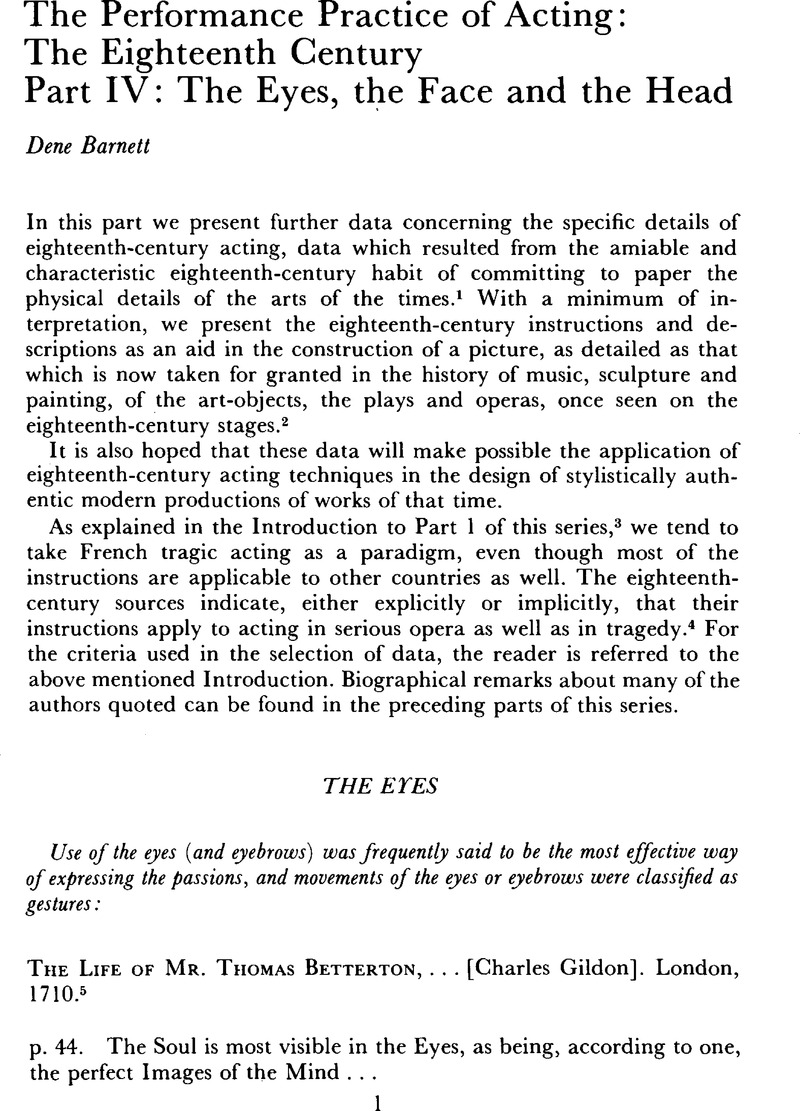No CrossRef data available.
Article contents
The Performance Practice of Acting: The Eighteenth Century Part IV: The Eyes, the Face and the Head
Published online by Cambridge University Press: 23 January 2009
Abstract

- Type
- Articles
- Information
- Copyright
- Copyright © International Federation for Theatre Research 1979
References
Notes
1. The research on which this paper is based was financed by the Australian Research Grants Committee, and by The Flinders University of South Australia.
2. I wish to express thanks to my research assistant, Jeanette Massy-Westropp for her expert contributions to this research.
3. For earlier parts of The Performance Practice of Acting see: Theatre Research International, Vol. II, no. 1, Part 1, Ensemble Acting; Vol. III, no. 1, Part 2, The Hands; Vol. III, no. 2, Part 3, The Arms.
4. See als: Barnett, Dene, ‘Die Schauspielkunst in der Oper. Das Achtzehnhundert’, in: Hamburger Jahrbuch für Musikwissenschaft, 3 (1978).Google Scholar Also: Barnett, Dene, The Performance Practice of Acting, 18th Century Serious Opera, forthcoming.Google Scholar
5. We are indebted to the following libraries for microfilms of some of the sources used in this paper: Bibliotheque de l'Arsenal, Paris; Bibliotheque Nationale, Paris; The British Library, London; New York Public Library, New York; The State Library of South Australia, Adelaide; Universiteitsbibliotheek, Amsterdam; Yale University Library, New Haven; Toneelmuseum, Amsterdam.
6. The French and Latin translations are by Jeanette Massy-Westropp. Leny Gillissen assisted with the Dutch translations.
7. In this passage Wilkes is quoting with approval a translation of Quintilian.
8. This passage is also used by Austin in Chironomia:… p. 380, footnote 6.
9. In this passage Wilkes is again quoting with approval a translation of Quintilian.
10. For further eighteenth century instructions that actors should act when listening as well as when speaking or singing, see Part 1 of this series, Ensemble acting, Theatre Research International, Vol. II, no. 1.
11. The question of acting in opera is dealt with at length in: Barnett, Dene, ‘Die Schauspielkunst in der Oper. Das Achlzehnhundert, in: Hamburger Jahrbuch fur Musikwissenschaft, 3 (1978).Google Scholar See also: Barnett, Dene, The Performance Practice of Acting, 18th Century Serious Opera, forthcoming.Google Scholar
12. Jelgerhuis was also a fine painter, and several of his cool and accurate paintings now hang in the Rijksmuseum at Amsterdam.
13. This was dealt with more fully in Part 1, Ensemble Acting, loc. cit.
14. That this holds even for a modern audience, has been verified by the writer in many productions in various countries, in which eighteenth century acting techniques were used in operatic and in non-musical works.
15. This passage was repeated verbatim in The History of the English Stage, Betterton, Thomas (London, 1741), p. 96.Google Scholar
16. Wilkes again quotes with approval a translation from Quintilian.


